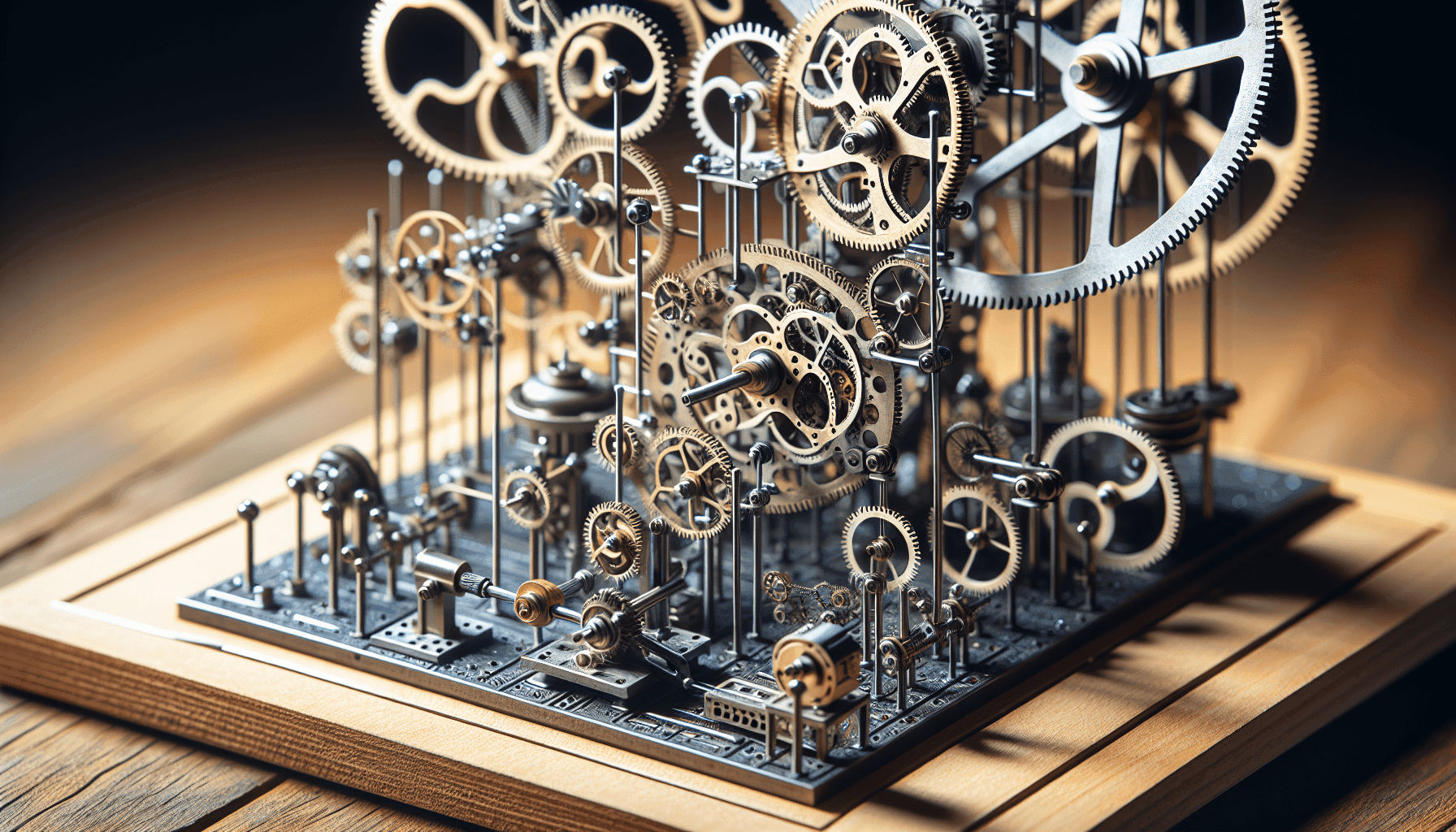Have you ever wondered if those intricate 3D wooden puzzles you see on display can really produce actual movement? It does seem a bit magical, doesn’t it? Rest assured, you’re not alone in this curiosity. Many puzzle enthusiasts and those with a penchant for mechanical marvels often ponder this question. Let’s journey through the fascinating world of mechanical models that dance, twirl, and move!
Understanding Mechanical Models
Mechanical models, often known as 3D wooden puzzles, are designed to mimic real-world mechanics in a miniaturized form. These models are assembled from laser-cut wooden pieces, and once complete, they are engineered to move through the interplay of gears, levers, and other mechanical elements.
How They Work
The operation of these models relies heavily on the fundamental principles of mechanics. By using gears and cranks, these models convert your manual input, like turning a handle, into movement. Think of it like how bicycles or watches work. Through a series of carefully orchestrated interactions, your effort is transformed into a delightful dance of moving parts.
The Role of Different Components
Gears: These are perhaps the most crucial elements, responsible for transferring and modifying motion and force. Essentially, they are wheels with teeth that mesh with other gears to create movement. In a wooden model, gears are often beautifully crafted and visible, adding to the model’s charm.
Cranks and Levers: By converting rotational motion into linear motion, these components are vital for transferring energy throughout the mechanism. You might find a crank is used to wind up the model, storing energy which is then slowly released to power movement.
Rubber Bands and Springs: Many models use elastic components to store energy. Winding a rubber band or compressing a spring accumulates potential energy that can later drive motion.
Building and Assembling the Model
The building process is almost as exciting as the model itself. It’s a unique combination of puzzle-solving and model-building which tests your patience and precision. But don’t worry; it’s all part of the fun.
Step-by-Step Assembly
- Unboxing the Kit: Start by reviewing the instructions. Most kits come with a comprehensive guide that walks you through each step.
- Organizing Parts: Arrange the pieces according to the stages of assembly. This will make it easier to find what you need when you need it.
- Building the Foundation: Begin with the base, which often holds the essential components that will drive the movement.
- Inserting Gears and Levers: Follow the instructions carefully to assemble the moving parts. Precision is key here, as any misalignment can hinder the model’s functionality.
- Final Assembly and Testing: Once all parts are in place, test your model to ensure movement flows smoothly.
Common Challenges and Solutions
- Misaligned Gears: If the gears don’t turn smoothly, check for any debris or misalignment and adjust accordingly.
- Loose Connections: If parts aren’t holding together, ensure all components are snapped or glued securely as instructed.
- Tight Fittings: If pieces are too tight, carefully sand them down for a better fit.

Exploring Popular 3D Wooden Model Brands
Let’s navigate through some of the prominent brands that create these mesmerizing mechanical models.
Robotime and Rokr
Known for their intricate designs and quality craftsmanship, Robotime and Rokr offer a broad range of models, from vintage cars to working clocks. They are celebrated for their attention to detail, ensuring each model is both a pleasure to build and a marvel to watch.
Ugears
Ugears stands out for incorporating artistic designs and complex mechanisms. Often inspired by real-life vehicles and machinery, their models delight in both motion and appearance.
Wood Trick
Focusing on educational value, Wood Trick models are not only entertaining but also educational. They encourage critical thinking and a deeper understanding of mechanics.
EWA and Vitascope
EWA and Vitascope brands similarly capture the essence of movement through well-designed kits. Their models often simulate historical mechanisms, adding an element of storytelling to each build.
Here’s a simplified comparison of these brands:
| Brand | Notable Features | Complexity Level |
|---|---|---|
| Robotime | Intricate designs and quality finishes | Medium to High |
| Ugears | Artistic and complex designs | High |
| Wood Trick | Educational and engaging instructions | Medium |
| EWA | Historical and story-rich models | Variable |
The Joy and Benefits of Building Mechanical Models
Building mechanical models is not just about the end result but also the rewarding journey. Here are some reasons why enthusiasts are captivated by this hobby.
Cultivating Patience and Precision
Assembling these models trains you to become more patient and attentive to detail. Each piece requires careful handling, and aligning gears and connectors sharpens your precision skills.
Stimulating Creativity and Problem Solving
Designing and building encourage creative thinking. You learn to visualize the assembly process and troubleshoot any issues. By engaging in this, you activate problem-solving skills that are applicable to real-life situations.
Relieving Stress and Promoting Relaxation
The hands-on nature of building models can be incredibly relaxing. It’s a therapeutic experience that allows for a break from the digital world, providing a soothing escape that refreshes the mind.

Practical Applications of Mechanical Models
Beyond their aesthetic value, mechanical models have practical applications that can be surprisingly beneficial.
Educational Uses
Educators often use these models to demonstrate basic mechanical principles in an engaging and interactive manner. They serve as a bridge between theoretical concepts and practical understanding.
Decorative and Collectible Values
Many find joy in decorating spaces with these models. Their intricate designs and functional movements can add sophistication and charm to any room. Not to mention, they often become treasured collectibles over time.
Inspiring Future Engineers
Young builders can find inspiration and motivation to pursue careers in engineering and design. Through hands-on engagement, they develop a passion for how things work, which can shape their future aspirations.
Unpacking the Question: Do They Really Move?
After all this, you might still find yourself asking: do these models actually produce movement? The simple answer is: Yes! When properly assembled, mechanical models are designed to move, often simulating the functions of the real objects they represent.
How Movement is Achieved
Movement occurs through the controlled release of stored energy, whether it’s via wound-up rubber bands or compressed springs. Gears translate this energy into motion, which travels through the model, bringing it to life.
Observing the Mechanisms in Action
Watching a mechanical model in motion is not just about the visual intrigue but the satisfaction of knowing you’ve constructed something with moving parts. It’s watching your hard work and attention to detail take form in a dynamic dance, proving that even small models can host big wonders.
Conclusion
Building and experimenting with 3D wooden puzzles introduces you to the captivating world of mechanics. These small models, crafted with precision and ingenuity, do indeed produce actual movement. It’s a satisfying blend of artistry, engineering, and personal achievement. Whether you’re crafting a vintage car or a musical instrument, the result is a miniature world of motion that reflects your effort and patience.
So, perhaps it’s time to jump right in! Embrace the unique challenge and let your creativity and curiosity guide you as you bring your own mechanical model to life.
Ready to start your 3D wooden puzzle journey? Click on any of the following links for our reviews:
All Categories | Boats | Clocks | Marble Runs | Musical Boxes | Musical Instruments | Puzzle Boxes | Trains | Trams | Trucks